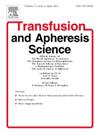Prevalence of transfusion transmitted infections by mode of donation and remuneration status among blood donors in Georgia, 2018–2023
IF 1.4
4区 医学
Q4 HEMATOLOGY
引用次数: 0
Abstract
Global reform of blood transfusion services is underway in the country of Georgia. New legislation mandates exclusive collection of blood from non-remunerated blood donors in Georgia by July 2025. Retrospective data (2018–2023) from the National Blood Donor Registry were analyzed. The prevalence was calculated for human immunodeficiency virus (HIV) antigen/antibody (Ag/Ab), hepatitis C virus antibody (anti-HCV), hepatitis B surface antigen (HBsAg). Results were stratified by remuneration status and mode of donation. Descriptive analysis was performed to elucidate differences in positivity by year and donor type. During 2018–2023, there were a total of 548,530 donations from 221,492 blood donors in Georgia; 68.3 % of donors were male and the median age was 34 years (interquartile range: 26![]() 44). Overall, 17.0 % were paid, 24.9 % were replacement, 47.4 % were voluntary non-remunerated blood donors (VNRBD), and 10.7 % had ≥ 2 donations of varying remuneration type. Paid donors had an average of 2.5 donations per year, compared to 1.0 for replacement, and 1.1 for VNRBDs. During 2018–2023, the proportions of paid donors decreased (38.8–22.1 %); the proportions of replacement (19.1–26.0 %) and VNRBDs (38.7–48.3 %) increased. Among first-time donors, prevalence decreased during 2018–2023 for anti-HCV (2.0–0.9 %) but were stable for HBsAg (range: 1.9 %-2.1 %) and anti-HIV (range: 0.1 %-0.2 %). Among repeat donors, prevalence of anti-HCV decreased (from 0.3 % to 0.2 %) while rates were stable for anti-HIV (0.04 %-0.1 %), and HBsAg (0.1 % in all years). The findings underscore the importance of donor retention in concert with efforts to attain exclusive VNRBD.
44). Overall, 17.0 % were paid, 24.9 % were replacement, 47.4 % were voluntary non-remunerated blood donors (VNRBD), and 10.7 % had ≥ 2 donations of varying remuneration type. Paid donors had an average of 2.5 donations per year, compared to 1.0 for replacement, and 1.1 for VNRBDs. During 2018–2023, the proportions of paid donors decreased (38.8–22.1 %); the proportions of replacement (19.1–26.0 %) and VNRBDs (38.7–48.3 %) increased. Among first-time donors, prevalence decreased during 2018–2023 for anti-HCV (2.0–0.9 %) but were stable for HBsAg (range: 1.9 %-2.1 %) and anti-HIV (range: 0.1 %-0.2 %). Among repeat donors, prevalence of anti-HCV decreased (from 0.3 % to 0.2 %) while rates were stable for anti-HIV (0.04 %-0.1 %), and HBsAg (0.1 % in all years). The findings underscore the importance of donor retention in concert with efforts to attain exclusive VNRBD.
2018-2023年格鲁吉亚献血者按献血方式和报酬状况划分的输血传播感染流行情况
全球输血服务改革正在格鲁吉亚进行。新立法规定,到2025年7月,格鲁吉亚只能采集无偿献血者的血液。分析了来自国家献血者登记处的回顾性数据(2018-2023)。计算人类免疫缺陷病毒(HIV)抗原/抗体(Ag/Ab)、丙型肝炎病毒抗体(anti-HCV)、乙型肝炎表面抗原(HBsAg)的流行率。结果按报酬状况和捐赠方式分层。进行描述性分析以阐明不同年份和供体类型的阳性差异。2018-2023年期间,格鲁吉亚221,492名献血者共进行了548,530次献血;68.3% 献血者为男性,中位年龄为34岁(四分位数差:2644)。总体而言,17.0 %是有偿献血,24.9 %是替代献血,47.4 %是自愿无偿献血者(VNRBD), 10.7 %有≥ 2次不同报酬类型的献血。有偿献血者平均每年捐献2.5次,而替代献血者为1.0次,vnrbd为1.1次。2018-2023年有偿献血者比例下降(38.8 - 22.1% %);替代比例(19.1 ~ 26.0 %)和vnrbd比例(38.7 ~ 48.3 %)增加。在首次献血者中,2018-2023年抗hcv患病率下降(2.0-0.9 %),但HBsAg(范围:1.9 %-2.1 %)和抗hiv(范围:0.1 %-0.2 %)的患病率保持稳定。在重复献血者中,抗hcv的患病率下降(从0.3 %下降到0.2 %),而抗hiv(0.04 %-0.1 %)和HBsAg(0.1 %)的患病率保持稳定。调查结果强调了保留供体与实现独家VNRBD的努力相一致的重要性。
本文章由计算机程序翻译,如有差异,请以英文原文为准。
求助全文
约1分钟内获得全文
求助全文
来源期刊
CiteScore
3.60
自引率
5.30%
发文量
181
审稿时长
42 days
期刊介绍:
Transfusion and Apheresis Science brings comprehensive and up-to-date information to physicians and health care professionals involved in the rapidly changing fields of transfusion medicine, hemostasis and apheresis. The journal presents original articles relating to scientific and clinical studies in the areas of immunohematology, transfusion practice, bleeding and thrombotic disorders and both therapeutic and donor apheresis including hematopoietic stem cells. Topics covered include the collection and processing of blood, compatibility testing and guidelines for the use of blood products, as well as screening for and transmission of blood-borne diseases. All areas of apheresis - therapeutic and collection - are also addressed. We would like to specifically encourage allied health professionals in this area to submit manuscripts that relate to improved patient and donor care, technical aspects and educational issues.
Transfusion and Apheresis Science features a "Theme" section which includes, in each issue, a group of papers designed to review a specific topic of current importance in transfusion and hemostasis for the discussion of topical issues specific to apheresis and focuses on the operators'' viewpoint. Another section is "What''s Happening" which provides informal reporting of activities in the field. In addition, brief case reports and Letters to the Editor, as well as reviews of meetings and events of general interest, and a listing of recent patents make the journal a complete source of information for practitioners of transfusion, hemostasis and apheresis science. Immediate dissemination of important information is ensured by the commitment of Transfusion and Apheresis Science to rapid publication of both symposia and submitted papers.

 求助内容:
求助内容: 应助结果提醒方式:
应助结果提醒方式:


